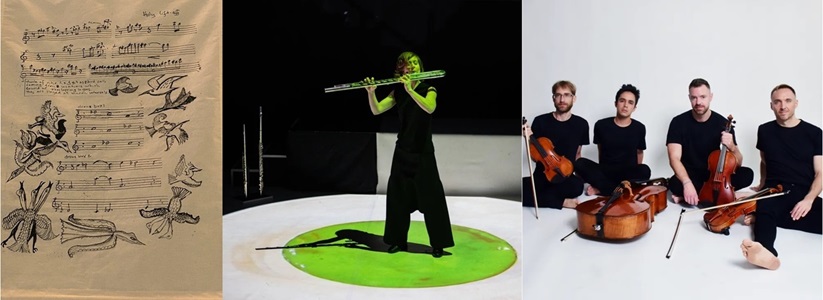
WHEN IS THE COMPOSER NOT THE COMPOSER?
STANFORD, CA—This open question was the foremost takeaway from the evening’s tour de force, a nonstop outpouring of intensity and virtuosity.
Terry Riley’s west coast premiere piece “The Holy Liftoff” raised these questions when his work was performed here May 8. Sample pages of his score showed his elaborate illustrations full of imaginary figures and whimsy—-but including merely 100 or so musical notes written out for the 75-minute nonstop work played by flute, string quartet and multiple prerecorded tracks, devoid of tempo or key signature markings. These notes, accounting for less than one percent of the notes played, recalled the 1960s vogue for graphic-notation music demanding musicians’ unprecedented creativity.
And his indeterminate whimsy carried over to the audience at the Bing Concert Hall. Afterward I examined a page of score and remarked with straight face, That imaginary bird is clearly related to the harmonic figures we heard 20 minutes into the nonstop opus. The stranger standing by examining the score played straight man and added, “Oh yes, no question, I heard that bird right there myself.”
The full performing score was made possible by the industrious “co-composer” Samuel Clay Birmaher, who created and in effect “composed” order and harmony out of the Riley fragments and pictures for the amplified quintet, with a lot of reverb, multiple prerecorded tracks, and the indefatigable flutist at center stage, New York virtuoso Claire Chase. A bit like Winton Marsalis before her, she played numerous roles at once, all but one prerecorded.
The one unquestionable takeaway from the concert was the virtuosic and amazingly animated flutist Chase, who capped it with a concluding cadenza running over a quarter hour, leaving one and all close to exhaustion. She could make the flute coo or make it sing. In Birmaher’s realization, this could be the loftiest test ever of a flutist’s technique and endurance (without even counting her multiple flute accompaniments previously set down).
The music ranged from bird-chirp simulations to the wild concluding jam session for the Jack Quartet and Chase. This work was the latest of Chase’s 24-year program of expanding available flute repertory, to conclude with the centennial of Edgard Varese’s seminal flute solo “Density 21.5.” Her arsenal included the orchestral flute, an alto flute and a bass flute (which resembles the sound of deep organ diapason), all played with great intensity and fiery lung power.
And if you thought flutes’ main task was delivering adagios to ballets, well, tune in on Chase’s versatile fireworks! Somebody, pass the lip salve.
For such soloists with infinite lungs, serving up any new contemporary music is like providing an aphrodisiac to any one else. The effect was intensified given the amplification of all five live instrumentalists. Add on assorted prerecorded sounds including percussion effects and even a few human voices, you have a collaborative sonic maelstrom lasting over one hour without a break.
Throughout Birmaher respected Riley’s traditional sonic conservatism, emphasizing seductive consonance. The stately early tempos accelerated during the performance to the finale frenzy, all seamlessly delivered without a break. Birmaher clearly did yeoman’s work here, yet he is dismissed in the credits with “as realized by,” rather than as co-composer.
All in all, “Holy Liftoff” is a unique showpiece that could take a vastly different guise under a different co-composer, one utilizing current technology to the max for its impact.
The essential sound engineer for this go-round was Emma Markowitz. Part of the concert enhancement at Bing was the soft-focus changing set of light projections through the evening.
MUSIC NOTES—Riley, the ex-East Bay product now living in Japan, admitted unfamiliarity with many techniques specific to flutes. He therefore turned to art work to make suggestions to the performers, encouraging their creativity as well….Riley, 88, is widely regarded as the father of minimalism via his wide-latitude “In C” for ensemble unveiled 60 years ago. In that work he claims that the worst performances have all been when performers hew closest to the written segments of score, i.e.: Musicians, be creative!
Chase has previously appeared as artistic director and soloist of the ICE Ensemble. Most recently, she was also one of the “collaborative partners” for SF Symphony maestro Esa-Pekka Salonen.
“HOLY LIFTOFF” by Terry Riley, “as realized by Birmaher,” in West Coast premiere, featuring flute soloist Claire Chase and the Jack Quartet May 8, Bing Concert Hall, Stanford University. For Stanford Live concert series info: (650) 724-2464, or go online, live.stanford.edu.